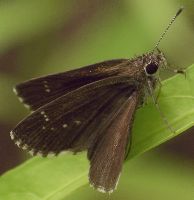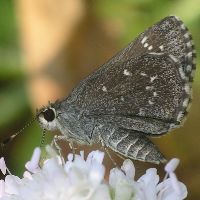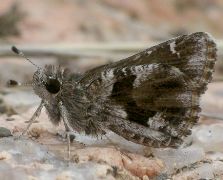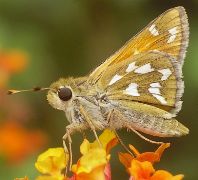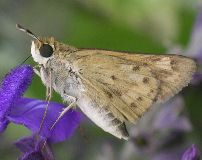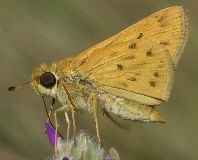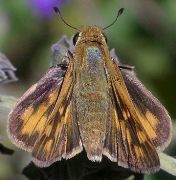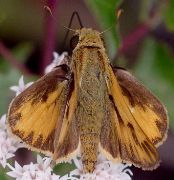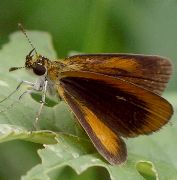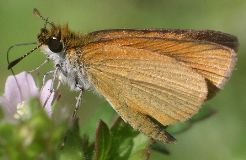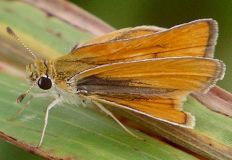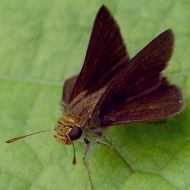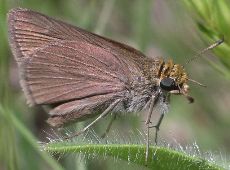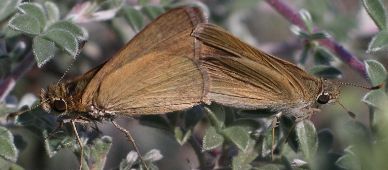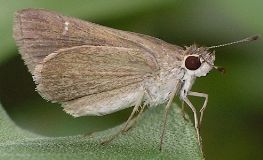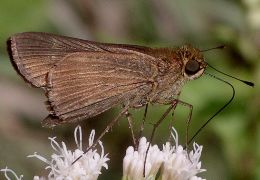
| Hesperiidae ~ Skippers |
|
Celia's Roadside-skipper (Amblyscirtes celia) is a very small and rather plain dark skipper that one must get close to in order to see details. Fresh individuals have black and white spotted fringe on their wings, but this wears off with age. The dark brown coloring, especially on the head, tends to be a bit grizzled with gray. This same frosted look of sprinkled white scales is quite evident on the undersides of the wings. There are also scattered white dots on the undersides of the hind wings.
There is another roadside-skipper that occasionally shows up in our area: the Nysa Roadside-skipper (Amblyscirtes nysa). This species is best identified by the underside of the wings, especially the intricate markings on the hind wings.
One occasional species that is very easy to identify is the Green Skipper (Hesperia viridis). This orange skipper has yellowish or olive green undersides to its wings, and the hind wings are marked with sharp white irregular spots. The Brazilian Skipper (Calpodes ethlius) is most often seen early in the morning. Very uncommon around here, it is rather large and dark brown with big glassy spots on the tops of the wings. The undersides of the wings, which are more often seen, are light brown and there is a series of three glassy spots on the hind wing. These need the right kind of lighting, though, to show up.
Another of the less common species is the Broad-winged Skipper (Poanes viator), a large skipper with rounded wings. The colors on the top of the wings are a variable brown with orange markings. The undersides of the wings are lighter in color, with a large tan ray extending out from the base of the hind wing. This ray is broken by a thin brown line about a third of the way from the base of the wing. There are several poorly defined light spots around the ray.
There are several small bright orange skippers in our area. The most commonly seen is the Fiery Skipper (Hylephila phyleus). Their large black eyes give them an absolutely elfin look. Males are bright orange, while females are darker. The undersides of the wings on males are also bright gold, with scattered black dots. These vary in intensity and number. The tops of the male wings have black margins that are zigzag on the inner side. This distinguishes them from other similar orange skippers. The undersides of the females' wings are light brown, and the hind wing has a chevron formed by a light band and small dark spots on the edges. The females sometimes also have iridescent blue on the top of their thorax but seeing this is highly dependent on angle and lighting.
Smaller than the Fiery Skipper, the Least Skipper (Ancyloxypha numitor) certainly deserves its name. The undersides of the hind wings are completely pale orange with no markings. The undersides of the forewings, though, have large dark spots that only show when the butterfly spreads its wings apart. The upper sides of the wings are much darker, with the hind wing having a large black border.
A similar small orange skipper is the Orange Skipperling (Copaeodes aurantiaca). It has no markings except for dark bases on the tops of the wings and a thin dark border to the forewings. Although it looks a lot like the Least Skipper, the Orange Skipperling can be identified by less rounded wings and a lighter upper side to the body, especially noticeable on the head.
The very smallest skipper in the U.S. is the Southern Skipperling (Copaeodes minima). This little sprite is so tiny that it often goes unseen. The orange wings have dark edges and dark bases on the upper sides of the hind wings and the undersides of the forewing. The best identification detail is a pale ray which extends from base to edge of the underside of the hind wing .
There are several plain brown skippers with very few markings. These can be quite a challenge to identify because slight differences in color are important. The Dun Skipper (Euphyes vestris) is fairly common. Males lack any white marks but females have a few white spots on the forewings. The best way to recognize this species is by the color of the head, which is almost always a yellowish gold color that appears different from the general wing and body color. The upper sides of the wings tend to be dark brown but the undersides are usually a rosy bronze color that appears ever so slightly metallic.
The Julia's Skipper (Nastra julia) is another plain brown skipper. I've not seen many of these, but the best indication of species is the warm brown color on the unmarked undersides of the wings. The tops of the wings are darker brown with a few yellow markings.
Much more common in our area is the similar looking Eufala Skipper (Lerodea eufala). This butterfly is also mostly unmarked on the undersides of the wings, but its color is a light gray instead of brown. It tends to look slightly dusty and the black eyes contrast sharply with the almost white lower body. The Eufala Skipper does have clear markings in the form of small white spots on the forewing that follow a semicircular shape from the leading edge of the wing.
The Ocola Skipper (Panoquina ocola) is a rather large brown skipper. Its wings are long and narrow, but with little in the way of markings on the undersides. There is sometimes a vague vertical whitish band across the underside of the hind wing, but often this is completely absent. The veins in the wings are prominent, giving the insect a rather rough look. The forewing has several white glassy markings, including a large arrow-shaped one. |
![]()
